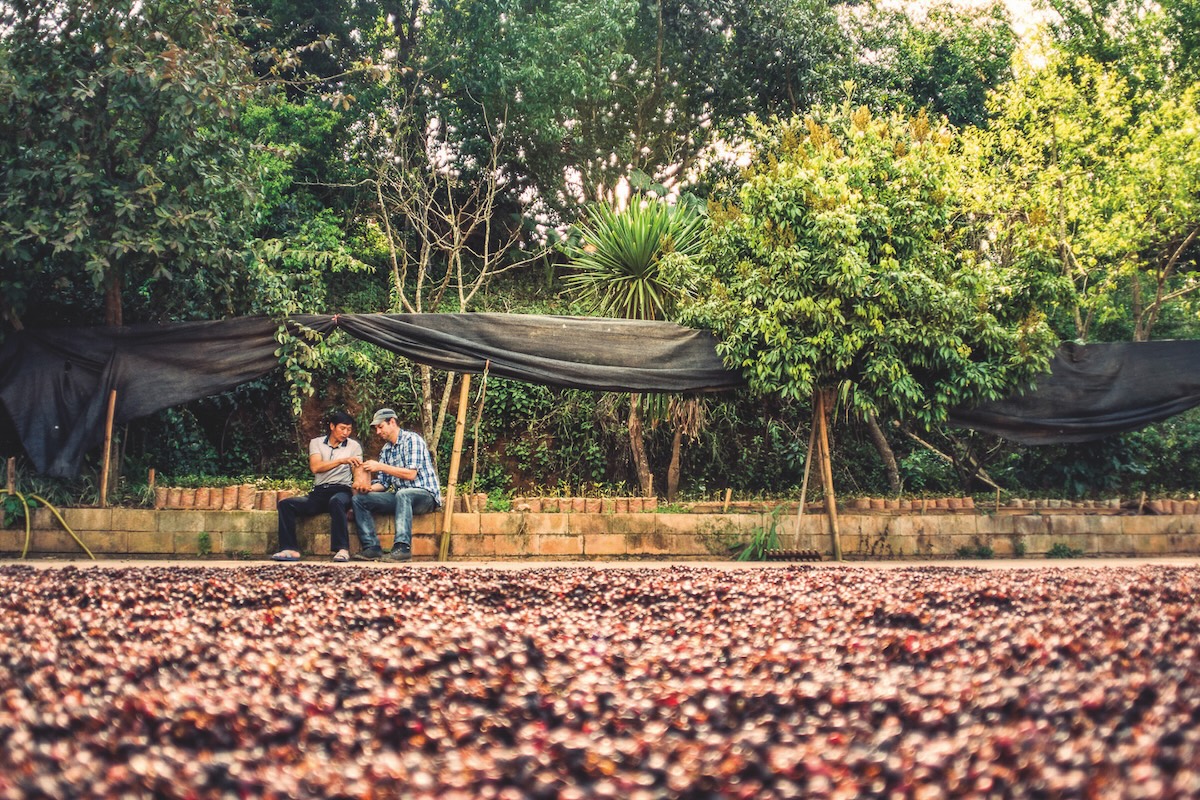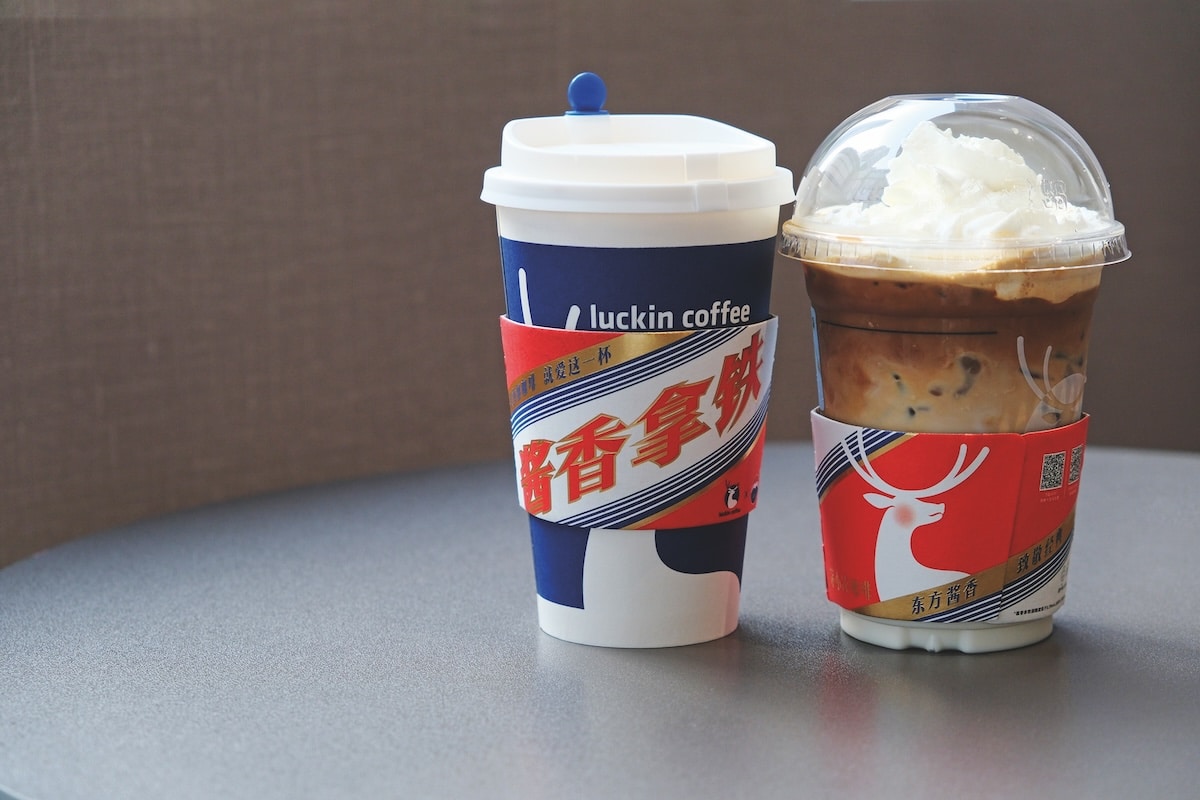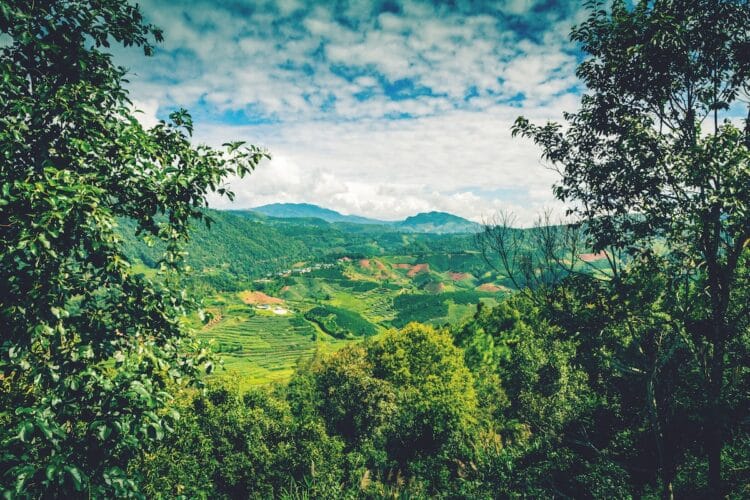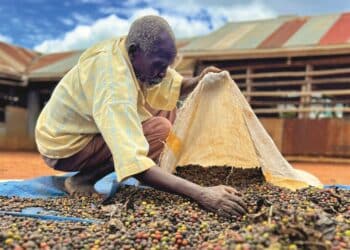How surging consumer demand and climbing production capabilities have accelerated China’s coffee market – with growth showing no signs of slowing.
Chinese coffee has long been a curiosity, but the sector has evolved far beyond simply being a passing point of interest.
The country’s coffee industry – from both a production and a consumer standpoint – is booming. A burgeoning specialty market is gaining traction thanks to quality beans grown in the Yunnan and Hainan provinces, while domestic demand for cheap and accessible coffee is growing alongside a desire to experience new and high-quality products.
While still famed for its production of pu’erh tea, Yunnan in the southwest has become the Arabica engine-room of Chinese coffee, with Robusta crops grown in the country’s southernmost region of Hainan.
With 1.9 million 60-kilogram bags produced in China in 2024/25 – compared to 105,000 bags in 1990/91 and 350,000 bags in 2003/04 – the industry is showing no signs of slowing down.
From humble beginnings
French missionaries first brought coffee to China, specifically Yunnan, in the 1800s. Yet, it wasn’t until the country began to open its doors to international trade in the 1970s that coffee started gathering any real momentum in a region that is, historically, a major tea producer.
Starting with instant varieties from the likes of Nescafé and Mars Coffee in the 1980s, coffee became a link to western influence and modernity – and was primarily an imported product.
Today, Chinese-grown coffee is exported all over the world, and Yunnan Coffee Traders is key to introducing the international coffee community to this emerging region.

Head of Global Sales Maarten Hol says the industry only really started transitioning from instant and commodity coffee to specialty and higher-quality beans in the past decade or so.
“Coffee production did not become commercially viable until the late 1980s when Nestlé and the Chinese Government started a large agricultural program to develop rural communities in Yunnan,” says Hol.
“Because there was no local knowledge to speak of and the aim was not to produce high-quality coffee, Catimor was chosen as a varietal for its high yield and ease of maintenance, and all of it was washed.
“Until around 2010, coffee was still hardly available in China other than some of the three-in-one instant coffee packets. Lots has changed now, mainly because of the growth of large chain cafés such as Starbucks, and off the back of western culture.”
United States (US) expat David Henry was one of those who struggled to adapt his own tastes to China’s coffee industry when he arrived in Shanghai in the 1990s. At the ground floor of China’s coffee boom in 2009, the former teacher took things into his own hands with the launch of Jonas Emil Coffee Roasters.
The micro-roaster services the home retail sector, with its products available to ship to mainland China, Macau, and Hong Kong, where it sells a range of locally and internationally grown coffee.
Henry says the approach to Chinese coffee, both domestically and globally, has changed dramatically since his arrival 30 years ago.
“I arrived here in 1995 as a teacher and I couldn’t find a cup of coffee. I’m a coffee lover who really thrives on the stuff and I had to stop drinking it for two years, which was really hard,” says Henry.
“When we started Jonas Emil, we were dependent on the foreign community. There were around 300,000 foreigners in Shanghai at the time. Of course, they were spread out, but that’s still a big market for a small roaster.”
Forging an industry
The arrival of Starbucks in China was a major turning point for the growth of the nation’s coffee sector. The US brand launched its first store in Beijing’s China World Trade Building in 1999, with its first store in Shanghai opening a year later.
Now, there are more than 7700 Starbucks stores in China spread across more than 1000 county cities. In 2022, Shanghai became the first city in the world to have 1000 Starbucks locations.
Along with being one of the largest coffee retailers in China, Starbucks is now also one of the largest buyers of Chinese beans in the world.
“We are proud to witness a dramatic improvement in the quality of Yunnan coffee – the percentage of coffee that passes Starbucks’ stringent quality tests has increased from 20 to 80 per cent since 2012,” a Starbucks spokesperson tells Global Coffee Report.
“Today, Yunnan coffee contributes to every part of Starbucks’ bean portfolio in China. Used in the signature Espresso Blend, Yunnan coffee can be found in every cup of dark-roast espresso-based beverage served across our more than 7700 stores. Yunnan Single Origin Bean, launched in 2017, is also sold in all our stores in China all year round.
“Since 2017, we have been proudly presenting Starbucks Reserve coffees from Yunnan every year. Twelve Yunnan Reserve coffees have been launched to date.”
Outside of growing its retail profile in China, Starbucks has been involved in introducing new and more efficient agriculture methods to Chinese farmers to help them grow higher quality coffee.
To do this, it has been involved in improving farming practices in Yunnan through the Starbucks Yunnan Farmer Support Centre (FSC), which offers farmers free agronomy expertise and resources.
“Since its opening in 2012, the FSC has trained more than 36,800 farmers on sustainable farming practices and 3411 farms have been verified through the Starbucks Coffee and Farmer Equity (C.A.F.E.) practices. As of September 2024, the cumulative certified area of these farms spans 352,465 miles,” the Starbucks spokesperson continues.
“We also purchase the coffee local farmers produce and pay higher prices for better quality. This creates a virtuous cycle where farmers are rewarded and incentivised to constantly improve the quality of their coffee. We typically pay farmers 20 to 30 per cent more than what they could fetch in the local market.
“Beyond profit, we foster farmers’ pride by honouring their efforts and connecting them to the cup of coffee in our customers’ hands. We organise the annual Yunnan Farmer Assembly, where we hand out quality awards to recognise successful farmers.”
Henry says the impact of Starbucks’ growth in China on the domestic market has laid the foundations for China’s modern coffee culture.
“When Starbucks came in, coffee became very fashionable. People in Shanghai like to be fashionable and they get really involved in trends, so coffee started to take off,” he says.
“It was inevitable that soon after people were going to start looking at coffee as a more serious, long-term thing.”

Going global
While domestic interest in Chinese coffee is growing, so is international demand. Hol reports the United Kingdom, European Union, Middle East, and Australia as major buyers of Chinese specialty coffee, while Russia and Germany purchase large amounts of its commercial coffee.
With global exports increasing, some previously held perceptions of Chinese coffee as an inferior product are quickly changing.
“As all emerging regions have, there is a lot of curiosity around Chinese coffee,” says Hol. “However, China as a producing country for other products has long been associated with bad quality.
“This, combined with some geopolitical influence, does affect the perceived status of Chinese coffee. We, as producers, deal with this is by emphasising the name Yunnan coffee rather than Chinese coffee.
“We have recently added ‘Product of China’ to our jute bags to slowly migrate to a narrative that pushes for a better perceived quality of Chinese coffee.”
He says while the dominance of Latin American countries in global Arabica production means China will likely never be one of the world’s top exporters of coffee, he still sees significant room for growth of its specialty industry.
“China is a very small player, so even though production will increase, the impact on the international commercial market will be negligible,” says Hol.
“But the impact on farmers wanting to evolve into specialty coffee producers has proven to be significant and will continue to evolve. Access to high quality equipment produced in country and the emergence of knowledge around specialty processing all contribute to the increase of local value in the value chain.”
This growing demand for new and different types of homegrown coffee has seen the emergence of new varietals grown in Yunnan.
“A new chapter has started that will again transform the Yunnan coffee scene. The introduction of alternative varietals such as Yellow Bourbon, Yellow Caturra, Pacamara, and Geisha are now actively being set up to provide a new flavour profile,” says Hol.
According to Henry, the transformation in both quality of farming and consumer demand for better products has been felt through the entire Chinese coffee industry.
“When we started Jonas Emil, we advertised all our coffee as 100 per cent imported Arabica beans. The Chinese growers were not specialty growers and it was very low-grade coffee. We just couldn’t sell it,” he says.
“Now, we sell a fair amount of Chinese coffee alongside our imported beans. The coffee from Yunnan is good. It’s very distinctive and not like Latin American or African coffees, but it has become noteworthy and has some great complexities.”
Creativity unlocked
A quick glance through the menus of some of China’s largest coffee chains shows the creativity in the Chinese coffee scene.
Local companies Luckin Coffee and Cotti Coffee are part of a new generation of businesses taking the domestic consumer sector by storm. Starbucks is no longer the only major player looking to tap into the local market.
Luckin claims to have more than 26,000 stores across its market of China and Hong Kong, Singapore, and Malaysia, and recently opened its first store in New York City, US. Cotti, on the other hand, says it operates more than 14,000 stores in 28 countries.
Outside the global standards like a cappuccino, espresso, or iced latte, consumers in China have options such as Luckin’s Apple Fizzy Americano, which combines sparkling soda and apple juice with espresso and hot water, or Cotti’s Pampas Blue Coco Latte, which blends espresso with milk, coconut milk, and blue colouring.
Henry believes the comparatively recent emergence of the Chinese coffee market means it’s not shackled to any preconceived ideas about what coffee should be, giving creativity room to grow.
“I’m 73 years old and I’ve been drinking coffee for a long time,” he says. “My dad and I used to have coffee made in an old percolator when I was in high school, and that was our evening ritual. I have ideas about what coffee should taste like, but that doesn’t really exist in China.
“People here come up with these wild combinations I wouldn’t even dream of, but they’re free from any kind of traditional bias. I shake my head at some of the fruity drinks that are concocted, but I have tried some and they taste pretty good. They’re really interesting.”

Over the past 16 years, Jonas Emil’s competition has grown and interest in its products has boomed.
“The coffee business has grown tremendously. When we launched there was one other foreign roaster that started about the same time. There were some local roasters, but they were very old school and used cheap beans with a dark, dark roast,” he says.
“The expansion has been phenomenal and the Chinese people have really taken to it. They have grown their sophistication of knowledge about coffee and the difference is incredible.
“In the space of a few years it has gone from ‘what’s coffee?’ to what it is now. It’s an industry that is open to trying anything new – there is so much experimentation going on. It’s been a wild ride.”
China’s domestic coffee industry is growing, but it’s still young and full of potential. According to the International Coffee Organization, the average coffee consumption per capita per year is just 0.15 kilograms.
If that reaches the global average of 1.36 kilograms, the domestic demand for coffee would grow to 31.7 million 60-kilogram bags, which would make China the single largest coffee market in the world, far surpassing the 25.9 million bags of the US.
Given that since 2010/11 consumption has grown at an average rate of 21 per cent, while the rest of the world’s average growth rate has been 1.8 per cent, it may only be a matter of time before that projection becomes reality.
This article was first published in the September/October 2025 edition of Global Coffee Report. Read more HERE.





